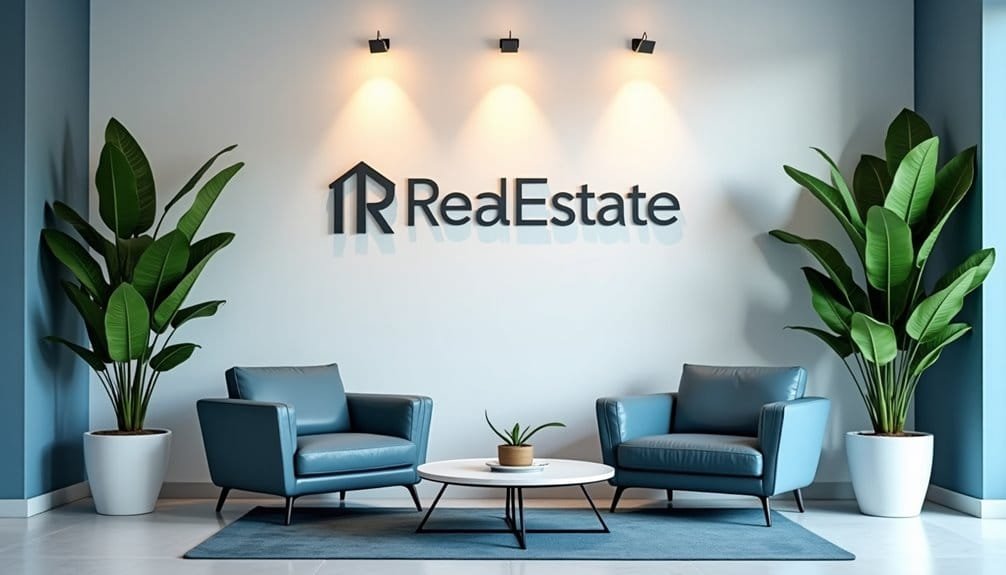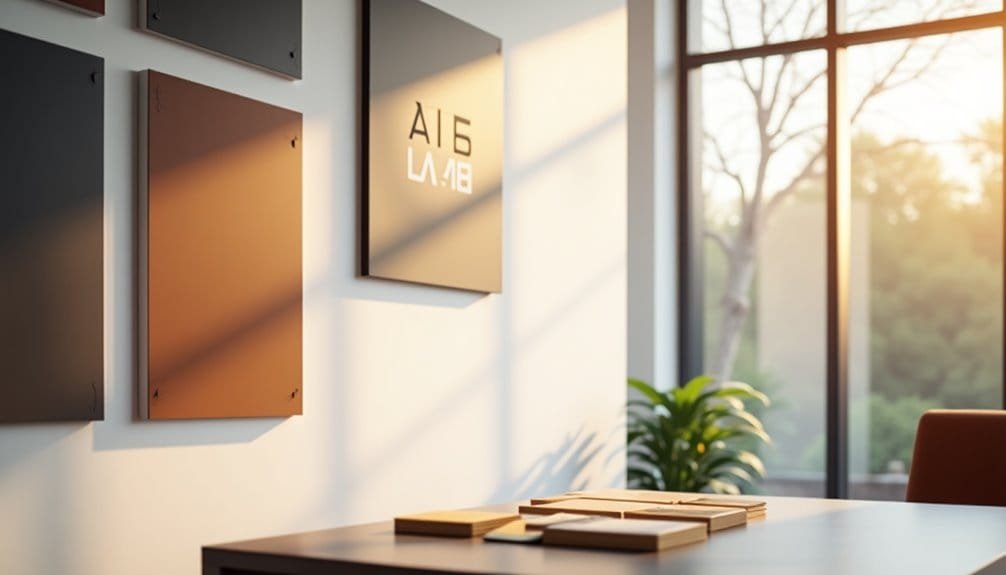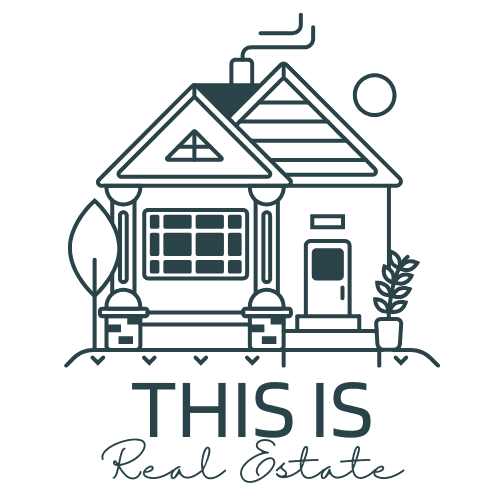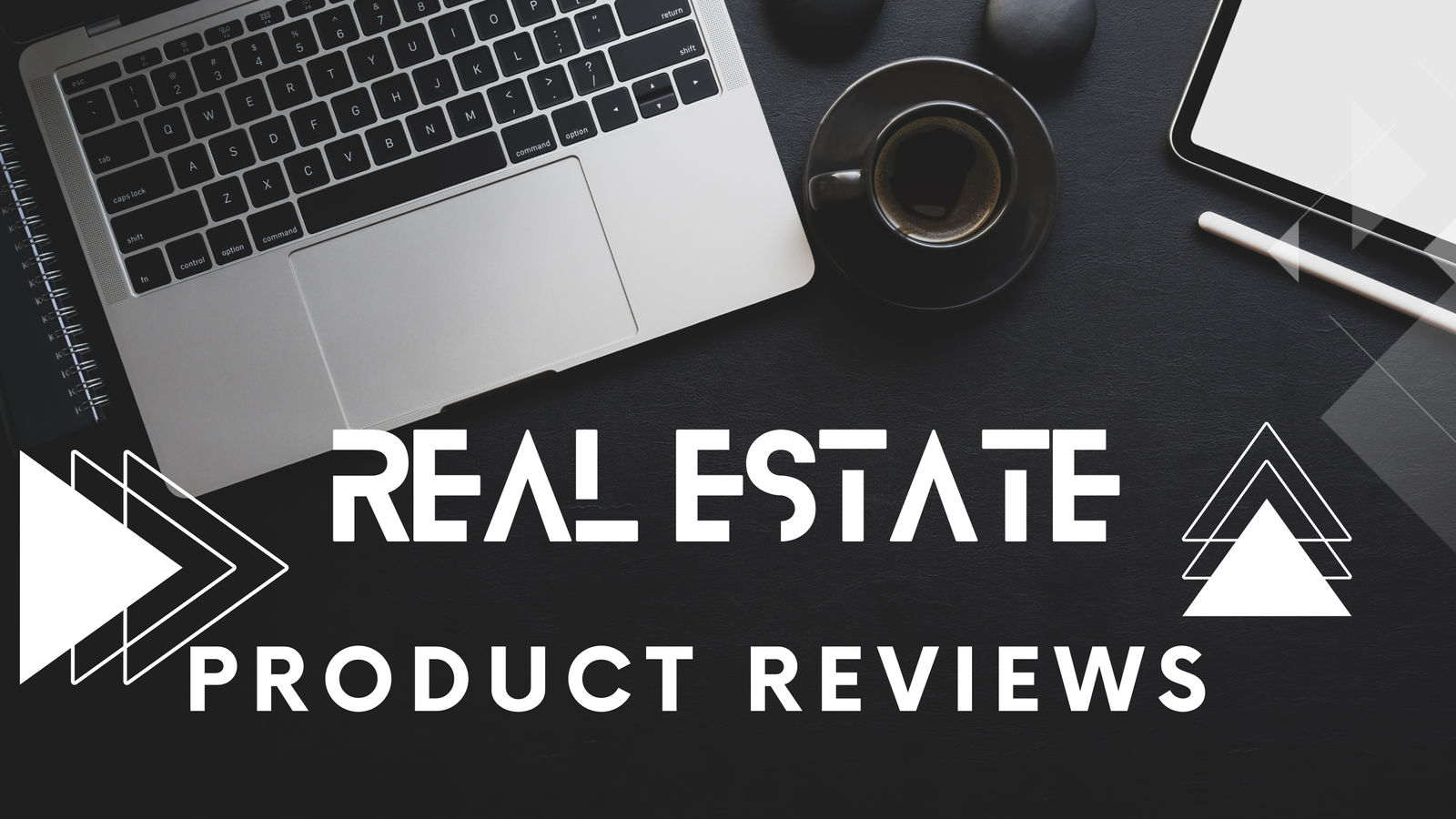When crafting your real estate brand, focus on selecting a logo and color scheme that effectively communicates trust and professionalism. Blue, a dominant color in the industry, signifies reliability while green highlights growth and sustainability. Your logo should reflect your brand’s unique identity by avoiding clichés and prioritizing simplicity, ensuring scalability across diverse media. Integrate professional typography, like Lato or Avenir, for enhanced readability and alignment with your target market. Consider using vibrant colors sparingly to capture attention and convey specific emotions. By incorporating these elements thoughtfully, you’ll build a memorable brand that stands out and resonates within the competitive landscape.
Key Takeaways
- Use blue in logos to convey trust and professionalism, as it appears in over two-thirds of real estate logos.
- Opt for minimalist designs to ensure logo memorability and versatility across marketing platforms.
- Choose typography that enhances readability and aligns with brand values, using professional fonts like Lato or Avenir.
- Incorporate unique iconography and avoid clichés to create a distinctive and memorable brand identity.
- Align colors with brand personality and target demographics to boost brand recognition and consumer appeal.
Real Estate Logo Color Trends

When you’re designing a real estate logo, color choices play a pivotal role in conveying your brand’s message. Blue, for instance, is a dominant choice, appearing in over two-thirds of real estate logos. It conveys trust, stability, and professionalism, essential traits for building client confidence. Notably, a survey indicates a strong preference for blue among designers, with its continued use anticipated in 2024 branding strategies, showcasing its enduring appeal. Research shows that 90% of product assessments are based on color within the first 90 seconds of viewing, highlighting the critical nature of selecting the right palette.
Green is another popular choice, selected in about 26% of design contests. It symbolizes growth, sustainability, and nature, perfect for eco-friendly or suburban markets. Black, often used in high-end branding, exudes luxury, sophistication, and authority, while gray offers a neutral, professional balance without overpowering other elements.
Emerging trends show a shift towards bold and bright colors, helping brands stand out. Yellow, used sparingly, conveys optimism and warmth; red, seen in about 29% of logos, suggests excitement and urgency. Orange adds warmth and personality, often as an accent. Vibrant colors can differentiate your brand, making a lasting impression.
Consistency in color usage across marketing materials is vital for recognition. Blue, green, and black remain staples among industry leaders, though experimenting with red and orange as accents can be effective.
Neutral colors like gray and white complement these choices, maintaining a balanced, professional design.
Effective Logo Design Strategies
Crafting an effective logo is both an art and a science, balancing creativity with strategic thinking. To make your real estate brand stand out, focus on creating a logo that not only captures attention but also conveys your brand’s unique identity and values. Effective branding requires a well-defined strategy, not just visuals, to build recognition and trust. Avoid clichés like building structures and rooftops, and instead experiment with unconventional symbols such as geometric shapes or patterns. Typography plays a vital role, where strong, simple text can effectively communicate your brand without imagery. A logo should be simple yet memorable, guaranteeing instant recognition. Originality is crucial in logo design to ensure your brand is distinct and engaging.
Here are four strategies to take into account when designing your logo:
- First Impressions Matter: A logo should grab attention and clearly convey your brand’s personality and values right from the start.
- Unique Identity: Develop a logo that distinguishes your brand from competitors, using creative design elements that reflect your real estate specialty.
- Professionalism is Essential: Make sure your logo looks professional, conveying expertise and authenticity to your audience.
- Invest in Quality: A well-designed logo can embody your brand essence, supporting long-term success and fostering brand loyalty through consistent exposure.
Understanding Color Psychology

Color psychology is a powerful tool in real estate branding, offering a way to influence perceptions and emotions through strategic color choices. Up to 90% of judgments about a product or service are based solely on color, making it essential to select them wisely. Different colors evoke various emotions; for instance, blue conveys trust and stability, while green signifies calmness and growth. By understanding these associations, you can create a lasting impression on potential clients. Choosing the right colors can simplify the buying and selling processes, as they can create illusions of space and luxury. Color recognition can be a deciding factor in consumer behavior, as roughly 62 to 90% of consumer judgment is based on brand colors.
In real estate, using the right colors can enhance brand recognition and communicate your values effectively. Consider the following table for common color associations:
| Color | Emotion/Association | Real Estate Use |
|---|---|---|
| Blue | Trust, Stability, Professionalism | Signals reliability |
| Green | Growth, Nature, Calmness | Suitable for eco-friendly markets |
| Red | Attention, Urgency | Used sparingly to avoid aggression |
Consistency in color use across marketing materials like flyers and brochures also boosts brand recognition. It’s important to align your color choices with your brand personality and target audience. For luxury clients, use purple to convey creativity and luxury. For broader appeal, neutral tones like gray and beige can be effective.
Crafting Distinctive Logos
As you harness the power of color psychology to build a compelling brand, it’s equally important to focus on crafting distinctive logos that encapsulate your real estate firm’s essence. A well-designed logo should be simple yet timeless, incorporating one or two colors with a clean, easy-to-read font. This simplicity guarantees memorability and avoids the pitfalls of fleeting trends that could date your brand. Additionally, a minimalist logo design is more likely to resonate well with modern audiences, ensuring your brand stands out in a competitive market.
Symbolism plays a vital role; consider integrating unique iconography, like houses or keys, to convey your real estate focus creatively. Utilizing negative space effectively can add visual interest and depth, enhancing the logo’s appeal. To ensure versatility across different marketing platforms, it’s wise to request multiple versions of the logo from your designer, including both vertical and horizontal formats.
Scalability is another significant factor. Your logo should maintain its integrity across various sizes and formats, from business cards to billboards. Choosing the right colors and fonts is essential, with blue, gold, and green being popular choices for their associations with trust, luxury, and growth. Professional fonts, such as sans-serif, convey strength and reliability, aligning with the brand’s tone.
Key Points:
- Simplicity and Timelessness: Stick to minimal colors and fonts.
- Symbolic and Unique: Use distinctive real estate symbols.
- Scalability: Guarantee clarity at all sizes.
- Color and Font Selection: Choose ones that reflect brand values.
Key Logo Design Considerations

What makes a logo truly stand out in the competitive real estate market? It’s all about combining the right typography, colors, imagery, and scalability.
When choosing fonts, opt for simple and professional ones that are clean and easy to read. Avoid anything that looks childish or unprofessional. A strong typography choice can stand alone without images, conveying competency and respectability. Traditional fonts with unique elements can set your logo apart, giving it a distinctive edge.
Color choices play an essential role in communicating your brand’s message. Blue suggests trust and reliability, making it a popular choice in real estate. If you’re in luxury markets, consider gold or silver to convey wealth and success. Green symbolizes growth and abundance, while red evokes strong emotions and urgency. Purple can add a touch of royalty and wisdom.
Imagery should be unique and relevant, steering clear of generic images like rooftops. Use local elements that reflect your region, or incorporate symbols like keys and trees to evoke a sense of home. Avoiding clichés is crucial as common design elements can make your logo blend in with countless others. A well-designed logo not only enhances brand recognition but also serves as the first impression that significantly impacts client perception.
For scalability, make sure your logo is simple and uncluttered, maintaining clarity across various sizes and platforms. Simplicity, in design, fosters memorability.
Modern Logo Design Trends
In the ever-evolving world of real estate branding, modern logo design trends are crucial to keeping your brand relevant and memorable. A well-designed logo can communicate your brand’s values and make a lasting impression on potential clients.
To create an impactful logo, consider the following trends:
- Font Selection: Bold typography conveys strength, while serif fonts suggest luxury and tradition. For a modern touch, sans serif fonts are ideal, and script fonts add sophistication. Custom typography, like altering a letter, can make a wordmark uniquely yours.
- Logo Composition: Wordmarks offer simplicity and elegance, often favored by luxury brands. Combination marks, which pair symbols with text, add visual interest. Minimalist designs with clean lines guarantee versatility, while geometric shapes can symbolize properties.
- Design Elements: Use negative space for depth, and stick to one or two primary colors for brand recognition. Typography and symbol integration create a cohesive look, and authenticity should reflect your brand’s mission.
- Adaptability: Confirm your logo is adaptable with vertical and horizontal lockups, scalable for different sizes, and versatile across platforms. Consistency in digital and print formats maintains a strong brand presence.
These trends will guide you in crafting a logo that resonates in the competitive real estate market.
- Prepare for Loan Maturities and Refinancing Waves as a Real Estate AgentIn mastering loan maturities and refinancing waves, uncover strategies every real estate agent needs to empower clients during pivotal financial transitions.
Choosing the Right Color Palette

Selecting the right color palette is essential for creating a compelling real estate brand that resonates with your target audience. Colors have powerful psychological effects, shaping perceptions and emotions.
Blue is a popular choice, featured in over two-thirds of industry-leading logos, due to its association with dependability and trustworthiness. It’s requested in more than half of real estate logo design contests, making it a safe, effective choice for conveying sophistication and approachability.
Consider using green if your properties emphasize nature or growth. It symbolizes fertility and stability, requested in about 26% of logo contests, and pairs well with black for a sense of authority and trust.
Black itself represents elegance and power, often seen in high-end real estate brands, while grey offers formality and credibility.
Red can inject energy and excitement, appearing in approximately 29% of leading real estate logos, but use it sparingly to avoid overwhelming potential clients.
For a modern twist, vibrant colors like yellow are trending, especially when combined with black text, providing a welcoming and positive vibe.
Ultimately, guarantee your color choices align with your brand message, target market, and industry norms for maximum impact.
Typography in Real Estate Branding
Typography plays a pivotal role in shaping real estate branding, guaranteeing your brand stands out with professionalism and credibility. Selecting the right fonts can make or break the perception of your real estate venture.
It’s essential for typography to convey professionalism, so choose fonts like Lato or Avenir to project a reliable image. Legibility is vital; fonts must be easy to read, especially when used in logos, headers, or body text.
Consistency in typography across all marketing materials helps solidify your brand identity, making it instantly recognizable.
Here’s a quick guide to enhance your real estate branding with typography:
- Font Combinations: Mix serif and sans-serif fonts for visual contrast and improved readability.
- Accessibility: Follow ADA and WCAG AA text spacing specifications to guarantee your content is accessible to everyone.
- Alignment: Use left-aligned text to adhere to best practices for accessibility and usability.
- Mobile Considerations: Opt for sentence case typography, limiting uppercase fonts for better readability on mobile devices.
Recent Posts

Building a Real Estate Business Plan: A Comprehensive Guide

How to Create a Real Estate Business Plan

Top Tools for Real Estate Lead Capture and Management
Frequently Asked Questions
How Do Real Estate Logos Impact Customer Perception and Trust?
Real estate logos greatly impact how you perceive a brand and build trust. A professional, well-designed logo makes a strong first impression, showcasing reliability and credibility.
By incorporating industry symbols like houses or keys, logos convey security and expertise, differentiating the brand from competitors. Consistency across platforms reinforces brand identity, while appealing designs foster emotional connections, enhancing brand recognition.
Ultimately, a memorable logo strengthens client loyalty and establishes long-term relationships.
What Role Do Cultural Factors Play in Real Estate Branding?
Cultural factors play a vital role in real estate branding by shaping buyer preferences and market trends.
You need to tailor your branding to reflect local cultural nuances, like popular architectural styles or color symbolism.
When you incorporate cultural imagery and local language into marketing materials, you engage the community more effectively.
Understanding and respecting cultural diversity can attract a wider client base, giving you a competitive advantage in the market.
How Can Technology Enhance Real Estate Logo Design?
You can enhance real estate logo design through technology by using online logo maker apps, which offer customizable typefaces and symbols.
Adjust font weights, letter spacing, and integrate unique symbols to make your logo distinctive.
Create thorough brand kits with various formats and colors, ensuring scalability across platforms.
Embrace clean, simple designs that effectively use negative space, and opt for timeless aesthetics to maintain relevance, avoiding fleeting trends.
What Are the Legal Considerations for Trademarking a Real Estate Logo?
When trademarking a real estate logo, you’ve got to guarantee it’s unique and doesn’t infringe on existing trademarks.
Registering it provides exclusive rights across Canada for ten years, with renewal options.
Avoid geographical terms unless they’re accurate. Misuse, like unauthorized REALTOR(R) use, leads to penalties.
Always display the logo according to design standards, using proper capitalization and symbols.
This protects your brand and keeps it legally sound.
How to Maintain Brand Consistency Across Various Marketing Platforms?
To maintain brand consistency across various marketing platforms, you should standardize your branding elements like logos, color schemes, and typography.
Develop and enforce brand guidelines to guarantee uniformity in all materials.
Regularly audit your online channels, updating them for coherence.
Ascertain offline materials mirror your online brand identity.
Train staff on brand standards, and leverage technology for streamlined consistency.
Monitor trends and refine strategies based on analytics and feedback to stay competitive.
Bottom Line
In crafting your real estate brand, focus on creating a logo that resonates with your audience by understanding color psychology and applying effective design strategies. Choose a color palette that reflects your brand’s identity and make certain your typography aligns with your overall message. Stay updated on modern design trends to guarantee your logo remains relevant. By considering these elements, you’ll build a distinctive and memorable brand that stands out in the competitive real estate market, inspiring community pride and trust.






